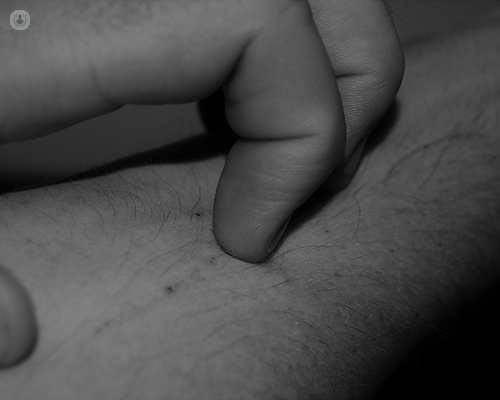5 facts about psoriasis
Written by:Psoriasis is a lifelong condition that varies in severity from person to person. The disease can cause considerable distress for sufferers because of common misconceptions – here we try to sort the fact from the fiction for Psoriasis Awareness Week.

 “People would put on gloves and not want to touch me because they thought it was, like, leprosy or something,”
“People would put on gloves and not want to touch me because they thought it was, like, leprosy or something,”
1. Psoriasis isn’t contagious and cannot be passed from person to person by skin to skin contact, as many people believe. Owing to such misconceptions and the appearance of the condition, people with psoriasis can often end up feeling isolated and many suffer from low self-esteem and anxiety, which can lead to depression. The actress and model Cara Delevinge (inset) spoke to the Times in 2015 about her experience with psoriasis and people’s perception of the condition, saying “people would put on gloves and not want to touch me because they thought it was, like, leprosy or something,”. For many, support groups play a vital role in living with the condition.
as many people believe. Owing to such misconceptions and the appearance of the condition, people with psoriasis can often end up feeling isolated and many suffer from low self-esteem and anxiety, which can lead to depression. The actress and model Cara Delevinge (inset) spoke to the Times in 2015 about her experience with psoriasis and people’s perception of the condition, saying “people would put on gloves and not want to touch me because they thought it was, like, leprosy or something,”. For many, support groups play a vital role in living with the condition.
2. Psoriasis affects around 2% of the population, typically causing patches of flaky red skin that may be itchy or painful. Whilst the most common sites for psoriasis are the elbows, knees, scalp and lower back, the condition can affect any part of the anatomy. Some people may experience a few, localized patches whilst more extreme cases may affect the whole body.
3. People with psoriasis have an increased production of skin cells. The usual lifecycle of cells is accelerated, resulting in a build-up of skin cells that leads to the patches that characterise the disease. The exact causes are unknown, however, it is widely thought to be caused by the immune system. Twin studies have also indicated it is at least partly genetic, although environmental factors such as stress, changes in the climate, alcohol, smoking, and obesity may also play a part.
4. The condition is usually first diagnosed under 35 and is chronic, meaning that it is usually lifelong, although it will very often consist of periods where there are no symptoms whatsoever. A diagnosis can usually be made by visual inspection of the skin. In a limited number of cases, a biopsy will be performed. This is where a sample of skin cells are taken for scrutiny in a laboratory to help to rule out other conditions and determine the type of psoriasis.
5. There is no cure for psoriasis at present, however, the disease can be managed with topical treatments (applied to the skin in the form of a cream or lotion), phototherapy (exposure to ultraviolet light) or systemic treatments (oral and/or injected medications). The type of treatment deployed depends on the severity of the symptoms, starting with topical treatments for milder symptoms. Psoriasis may also have environmental triggers – it can be helpful to work out what these are and avoid them.


